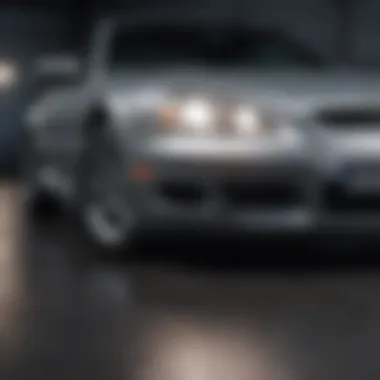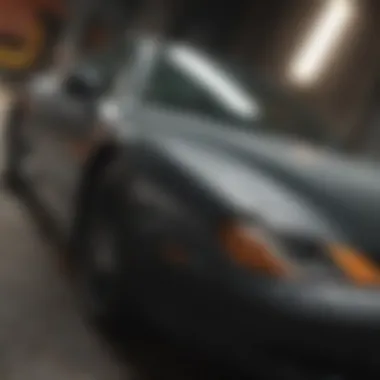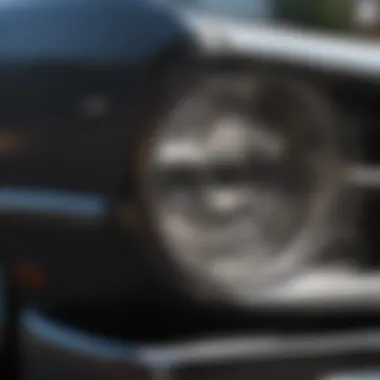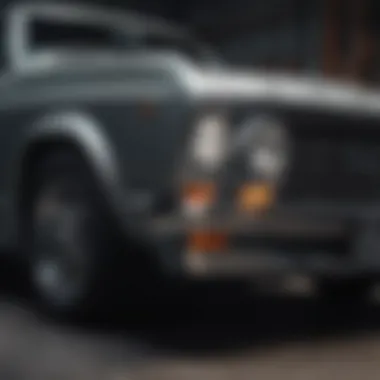Polishing Plastic Headlights: A Complete Guide to Clarity


Intro
Plastic headlights have become ubiquitous in today’s automotive design. Their lightweight and cost-effective properties have led manufacturers to favor them over traditional glass options. However, these plastic headlights often undergo clouding and discoloration, primarily due to UV exposure, environmental pollutants, and general wear and tear. This degradation not only increases dimness but also affects the overall appeal of the vehicle.
Understanding how to restore plastic headlights is essential for both everyday car owners and automotive enthusiasts. Regular maintenance not only enhances the appearance of the vehicle but ensures the functionality of headlights, which directly impacts safety during driving. By employing the right techniques and solutions, one can effectively reverse the effects of exposure and aging.
Car Reviews
While this section dives into specific models, focusing on their headlight conditions can reveal larger trends in automotive design and technology.
Overview of the Vehicle
Before discussing headlights, it is essential to consider the vehicle's entire structure. Many modern vehicles come equipped with intricate lighting designs built into the bodywork. Often, the design choices made by manufacturers can contribute to the longevity of plastic headlights. Models such as the Toyota Camry and Honda Accord utilize not just aesthetic appeal in their designs but also practical materials.
Performance Analysis
Headlights directly contribute to the performance of a vehicle’s safety systems. Cloudy or discolored headlights result in reduced visibility, especially at night or during adverse weather conditions. For instance, tests show that vehicles with damaged headlights have a significantly higher incidence of nighttime accidents. It is clear that maintaining headlight clarity plays a role in driving performance.
Design and Interior Features
Today’s headlights are part of a broader design theme aimed at aerodynamics and aesthetics. Features, including projection lamps and LED options in cars like the Mazda 6, can enhance the visual appeal but may lead to different issues with headlight degradation. The integration of modern materials is pivotal yet vulnerable to environmental factors.
Safety Ratings and Specifications
Safety ratings are essential, and often consider the effectiveness of headlights. Organizations, such as the Insurance Institute for Highway Safety, assess how well vehicles perform in night driving. Poorly maintained headlights can lower safety scores for otherwise exceptional vehicles.
Value for Money
The long-term implications of maintaining clear headlights should weigh in vehicle purchase decisions. For many buyers, models like the Subaru Outback may offer durability and ease of headlight maintenance, resulting in higher satisfaction and reduced costs over time.
Guided insights into specific models demonstrate how small omissions impact overall performance. Keeping headlights clear is both a safety consideration and a value proposition for car owners, ensuring both beauty and functionality endures through time.
Finale
Maintaining your vehicle's plastic headlights is more than a cosmetic gesture. It protects your investment, ensures safer driving, and preserves the vehicle's appearance over time. Through professional techniques or home solutions, restoring clarity and function is an attainable goal. That being said, it remains crucial to understand how design choices impact headlight health and seek effective upkeep measures.
Understanding Plastic Headlights
Plastic headlights are common in modern vehicles, and they offer several advantages over traditional glass headlights. They are lighter, which contributes to overall fuel efficiency, and they can be molded into complex shapes that improve aerodynamics. However, these benefits come with challenges, particularly regarding durability and clarity over time.
Composition and Construction
Plastic headlights are primarily made from polycarbonate, a durable thermoplastic material featuring strong impact resistance. This composition allows them to withstand the rigors of driving, including road debris and weather conditions. Additionally, many headlights come with a protective coating that provides a layer of defense against scratching and UV damage. Over time, however, even the best-quality plastics can degrade due to prolonged exposure to sun and environmental pollutants.
A significant number of manufacturers apply a UV-cured hard coat to polycarbonate as a protective measure. While this increases clarity and gloss immediately after manufacture, it can become susceptible to wear, especially in regions with harsh weather. This understanding is beneficial for car owners seeking effective maintenance solutions to prolong the lifespan of their headlights.
Common Causes of Degradation
Despite their initial robustness, plastic headlights often succumb to degradation due to multiple factors. The following points outline common causes:
- UV Radiation: Prolonged exposure to sunlight leads to yellowing and clouding as the protective layer degrades.
- Oxidation: Air and moisture react with the plastic surface, bringing about deterioration.
- Road Debris: Small rocks, dust, and grime impact the headlights and create scratches that never fully recover.
- Chemical Exposure: Car washes, especially those with abrasive agents, as well as pollutants like road salt and oils, can negatively impact clarity.
Understanding these causes provides crucial insight for vehicles owners on how the headlights might suffer over time. It can lead them to realizations about maintenance practices that can prevent or slow down the degradation process of their essential components.
The Importance of Headlight Clarity


Maintaining the clarity of plastic headlights is crucial not only for aesthetics but also for functional safety while driving. Cloudy or discolored headlights diminish the effective range of illumination, which increasingly becomes hazardous as darkness sets in. This section will discuss the significant elements related to headlight clarity, detailing both safety considerations and aesthetic impacts on vehicles.
Safety Considerations
The most pressing reason for ensuring clear headlights lies in safety. According to various studies, degraded headlight performance occurs mainly due to the exposure factors such as UV radiation, environmental pollutants, and moisture. The opacity formed on headlights restricts the amount and direction of light, resulting in decreased visibility for the driver, especially under low-light conditions.
- Legal Aspects: Many regions have regulations regarding the minimum performance standards for vehicle lighting. Going against these can render the car illegal for use on roads, incurring fines and penalties.
- Risk of Accidents: Poor lighting can significantly contribute to accidents, as drivers have more difficulty seeing road signs, pedestrians, or other vehicles. According to NHTSA data, nearly 50% of driving accidents happen at night—some of which could potentially be mitigated by enhanced light visibility from headlights in good condition.
- Economic Impacts: Reducing accidents comes with economic benefits. Lower insurance premiums are conceivable after improved vehicle safety, not to mention the savings associated with not having accidents, injury claims or dealing with repair costs.
Maintaining headlight clarity can drastically reduce your chance of accidents, enhancing not just your safety but also that of all road users.
Aesthetic Impact on Vehicles
Clarity in headlights is increasingly relevant when considering the overall appearance and value of the vehicle. A car with foggy, yellowished headlights can look neglected, reflecting poorly on how a driver takes care of it. The following points summarize the aesthetic impacts:
- First Impressions: Clear, well-maintained headlights play a crucial role in the first impression of a vehicle. They contribute positively to the perceived value during resale. Buyers naturally incline towards well-kept cars.
- Harmony of Design: Vehicles are often designed with intricate aesthetics where all factors should harmonize. Cloudy headlights can clash visually, disrupting the elegant lines and designs that manufacturers strive for.
- Pride in Ownership: Driving a vehicle with clear headlights boosts owner satisfaction. Many automotive enthusiasts keep up with maintenance because it aligns with their pride in owning a well-kept vehicle.
Factors such as safety and aesthetics emphasize the necessity for maintaining the clarity of headlights not just as an obsession for car enthusiasts, but as an important consideration for all drivers. Continuous vigilant care ensures both necessary visibility on the road and an inviting appearance of one’s vehicle.
Tools and Materials for Polishing
When it comes to polishing plastic headlights, the choice of tools and materials is crucial. The right items not only improve the quality of the results but also ensure the process is efficient and effective. Understanding this component of the process will make distinguishing between temporary fixes and long-lasting solutions easier. Various methods can lead to headlight restoration, factoring in time, costs, and accessibility to these resources. Proper tools and materials assist in delivering a finish that is clear and smooth, enhancing both safety and aesthetics.
Essential Supplies
Several essential supplies stand out in headlight polishing. These form the foundation for a successful procedure. A basic understanding of each item’s role ensures you achieve desired outcomes.
- Car Wash Soap: A mild car wash soap removes dirt and grime. It is an essential step before any polishing can begin. Everyday household soaps may be too abrasive.
- Microfiber Cloths: Use microfiber cloths for cleaning and polishing. They are soft, non-scratch, and highly absorbent.
- Sandpaper: Grades between 1000 to 3000 grit are necessary. These are used for smoothing out the headlight surface. For severe yellowing, start with a lower grit and work towards a finer one.
- Plastic Polish: Available in various formulas, it can restore clarity. Choosing a product specifically made for plastic or automotive use is vital.
- Masking Tape: This helps protect areas around headlights from scratches or polish residue. It also allows for clear lines, which is aesthetically pleasing.
- Water: Throughout the process, having ample amount of water is crucial, especially when using sandpaper. It assists in lubrication and reduces dust.
Optional Products and Additives
Beyond the essentials, there are optional products and additives that can augment the headlight polishing processes. While not strictly necessary, these can provide additional benefits. Assess your individual needs and goals to determine what might suit you best.
- Headlight Restoration Kits: Commercial kits often include the needed components for polishing, along with tools and solutions tailored for stubborn cloudiness. While sometimes pricier, they simplify the approach.
- Sealer: Applying a UV sealant post-polishing extends the life of your freshly polished headlights by protecting them from future degradation. This is especially helpful in regions with a lot of sunlight.
- Polishing Machine: For enthusiasts looking to take their abilities up a notch, an orbital polishing machine may save time and effort. It provides a uniform polish that manual methods might lack.
- Rubbing Compound: Some may find that a rubbing compound rushes the deep scratch removal process. Used carefully, it can complement your polish to create a clear polish effect.
Having the right tools for the task is essential to ensuring that you not only clean but also rejuvenate the headlight’s surface instead.
Exploring both essential and optional supplies enables readers to assess what works best given their skills and expectations. With this knowledge, you're ready to dive into polishing your headlights effectively.
Step-by-Step Guide to Polishing Headlights
The process of polishing headlights entails more than just restoring clarity; it also significantly affects safety and overall vehicle aesthetics. Properly polished headlights allow for better visibility at night or during inclement weather. This step-by-step guide provides a comprehensive overview of the necessary procedures one must undertake, ensuring both effectiveness and efficiency in headlight restoration.
Preparation of the Work Area
Before embarking on polishing, it is essential to prepare the work area properly. An organized space enhances focus and reduces disruptions, fostering a more efficient process. Choose an area that is well-lit, preferably shaded from direct sunlight, as this helps to see any imperfections clearly.
Key preparatory steps include:
- Gather all necessary tools and materials at one place to avoid interruption. This includes cleaning solutions, microfiber cloths, polish, and a buffer.
- Clear the surrounding area around the vehicle to prevent tripping hazards.
- Consider laying down a tarp or old sheet to catch any debris and prevent unwanted mess while you work.
By ensuring that these preliminary steps are completed, you can create an environment that is conducive for a successful headlight polishing task.
Cleaning the Headlight Surface
Once the work area is set up, thoroughly cleaning the headlight surface comes next. Dirt, grime, and debris can interfere with the polishing process, so skipping this step is not advisable.


Start by using a gentle automotive soap mixed with water. Use a soft sponge or cloth to wipe down the headlight. Once it is clean, rinse with water and dry with a microfiber towel. This prevents any scratching on the lens during the polishing stage. As you clean, pay close attention to the edges and corners to remove all debris.
Additionally, employing glass cleaner can further enhance the clarity, thereby allowing for a more effective polishing application later.
Applying the Polish
With the surface clean, it’s time to apply the polish. Selecting the right product is vital for optimal results. Look for a plastic polish specifically designed for automotive purposes.
Here are the steps to follow:
- Apply a small amount of polish to a clean applicator pad. A generous amount can work at times, but a little often suffices for effectiveness.
- Begin on a small section of the headlight using moderate pressure and circular motions. Doing so helps in an even distribution and ensures comprehensive coverage.
- Make sure to apply polish in overlapping circles to address all areas uniformly. This technique helps to enhance the grinding effect, which is essential in diminishing cloudiness.
It is advisable to consult the instructions of the polish product, since the application methods may slightly differ between products.
Buffing Techniques for Optimal Results
After applying the polish, buffing plays a critical role in achieving clarity. Using a buffering tool or a microfiber cloth will often yield better outcomes.
For effective buffing:
- Maintain consistent pressure across the lens. It helps avoid uneven results.
- Follow the same circular motion used for the application of polish. This routine will enhance the ability to eliminate scratches caused by earlier oxidation.
- Repeatedly evaluate the light transparency between buffing motions to assess your progress.
Remember, persistence leads to excellent outcomes whereas impatience can lead to unsatisfactory outcomes.
Final Clean-Up and Inspection
Finally, the cleaning of the workspace and a thorough inspection of the headlights represent crucial concluding steps.
- Start by cleaning any remnants of polish with a soft, damp cloth. Make sure to get every corner.
- After cleaning, an inspection of the headlights should highlight progress made. If the clarity is still insufficient, consider repeating the polish application and buffing until satisfactory clarity is reached.
As a last step, be sure to inspect the entire vehicle for any polish residue that might have settled during the process to ensure it remains pristine and professional.
Key Points: Good preparation and thorough cleaning greatly impact the success of headlight polishing. Correct application and buffing techniques followed by careful inspection ensures noticeable improvement in headlight clarity.
Alternative Methods for Headlight Restoration
When it comes to restoring the clarity and shine of plastic headlights, it's essential to explore various methodologies. Not everyone has the luxury to access professional services, and not all vehicles warrant such an expenditure. Understanding alternative methods for headlight restoration can empower vehicle owners. It allows them to make choices that suit their circumstances while potentially saving them money.
Utilizing home remedies or commercial restoration kits can present unique benefits. Primarily, these methods can be more cost-effective compared to professional services. They also give car owners a sense of control in improving their vehicle's appearance and safety. This approach aligns with common tendencies among automotive enthusiasts to take matters into their own hands, promoting a sense of ownership and maintenance. However, one has to consider the effectiveness and longevity of these methods. Some might yield temporary results while lacking durability against environmental factors.
Home Remedies and DIY Solutions
Exploring home remedies and DIY solutions provides numerous avenues for vehicle maintenance without breaking the bank.
Some popular DIY solutions include:
- Baking soda and vinegar paste: Combining baking soda with water to make a thick paste, then adding a splash of vinegar, can create a gentle abrasive mix. Apply it with a soft cloth and rub the headlight in circular motions.
- Toothpaste application: Toothpaste, especially the whitening kinds, can work wonders. It acts as a mild abrasive and offers an effective method for penetrating the cloudiness. Just apply a small amount using a cloth, then wipe clean with water.
- Lemon juice and baking soda: This mixture can not only clean but also greet with a refreshing scent. It balances mild acidity with abrasiveness, allowing decent results.
When pursuing these DIY methods, it is vital to ensure proper protocol and environmental considerations for the materials used to avoid damage to the vehicle or the environment itself.
Commercial Headlight Restoration Kits
Commercial headlight restoration kits offer another dimension to preserving the quality of headlights. Through purchasing specialized kits, car owners can access tailored solutions, ranging from abrasives to protective sealants designed for long-lasting results.
For instance, the 3M Headlight Restoration Kit is often reviewed positively due to its comprehensiveness and user-friendliness. Similarly, the Sylvania Headlight Restoration Kit offers a no-sanding option, allowing ease of use while not compromising effectiveness according to user testimonials. ProPaint has also gained recognition for its performance.


When evaluating these kits, consider:
- User reviews for reliability: Acquiring first-hand accounts often aids in gauging the performance of these items before investment.
- Cost-effectiveness: Compare the kit’s cost against professional services by analyzing expected longevity and durability of the restoration achieved.
- Ease of use: Most kits come with approachable step-by-step instructions. Ensuring you are comfortable with these procedures can facilitate optimal results.
Ultimately, these alternative methods, be it through home remedies or buying kits, serve to enhance the appearance and utility of plastic headlights. Each carries distinct advantages, urging owners to choose whatever best fits their lifestyle and needs.
Preventive Measures for Longevity
Preventive measures are crucial in maintaining plastic headlights. Such strategies help enhance their lifespan and retain clarity, serving both safety and aesthetic purposes. Consistent upkeep shields headlights from the rigors of environmental exposure. The importance of these measures cannot be overstated. Undertaking routine cleaning and applying protective solutions are effective ways to prevent degradation.
Regular maintenance routines not only clean the surface but also contribute to early detection of any signs of wear. This proactive approach ensures problems are addressed before they become severe.
Headlights face various hazards, from UV rays to road debris. Left unchecked, these elements contribute to dullness and clouding, leading to impaired visibility at night. Protecting headlights means enhancing driving safety. Moreover, well-maintained headlights positively impact the overall look of the vehicle. They are often overlooked, yet faded headlights can detract from even the finest vehicle design.
In addition to routine check-ups, using protective coatings becomes vital. These products create a barrier, safeguarding the headlights against wear and tear. Integrating a mixture of simple but effective protective solutions guarantees eventual savings in terms of restoration costs. By preserving the integrity of the headlights, car owners can enjoy efficient driving experiences and improve their vehicle's resale value in the long run.
Regular Maintenance Routines
Regular maintenance is key to ensuring the prolonged clarity and functionality of plastic headlights. Setting a routine can significantly diminish the effects of dirt accumulation and UV degradation..
Suggested Routine Actions:
- Washing: Regularly wash your vehicle, paying close attention to the headlights. Dirt and grime can accumulate, dulling clarity over time.
- Inspection: Check headlights for signs of cloudiness or scratches during routine car washes. Early detection is ideal.
- Surface Protection: Applying car wax or a protectant keeps the headlight surface smooth and resistant to contaminants.
**Blockquote:
When to Seek Professional Help
Plastic headlights can undergo significant wear and tear. Despite many home remedies and DIY solutions, there are times when the damage might require professional intervention. Understanding when to seek help from a specialized technician is crucial. It aligns with the ultimate goal of ensuring that headlights remain safe and effective.
Identifying Severe Damage
Over time, various factors can lead to severe damage on plastic headlights. Common indicators include:
- Deep Scratches: If the scratches into the surface material rather than just the outer layer, extensive polishing may result in reducing the structural integrity.
- Extensive Yellowing: If the lens is consistently yellowed despite repeated polishing attempts, this often points to deeper issues that DIY techniques cannot resolve.
- Dilapidation: Cracks or brittle areas signal degradation that may cause headlight assemblies to fail, leading to potential replacements.
To efficiently gauge your headlights’ conditions, do a comprehensive examination under different lights. If issues persist beyond surface clarity, it might be time to exit the DIY route.
"Prioritize the clarity of your headlights for enhanced visibility and safety while driving. Stubborn damages necessitate professional restoration."
Evaluating Cost-Effectiveness of Professional Services
Choosing whether to engage professionals involves several considerations. Evaluating cost-linked factors can help in deciding:
- Long-Term Value: Think about potential accidents that might arise due to low visibility from poorly maintained headlights. Cost of repair or medical might outweigh the expense of professional services.
- Tools and Skills: Professional repair may seem pricier but it often involves specialized tools and experience. Home tinkering might yield short-term satisfaction but no long-lasting benefits.
- Guarantees on Work: Trusted professionals may offer warranties for their work. If a problem reoccurs, sometimes they will rectify the job without additional costs.
Thus, analyzing these elements provides insights into gaining value. If uncertainties about condition and effectiveness continuously arise, considering professionals' insights will lead to a clearer judgement. This action reflects the priority on safety and ongoing headlight function.
Ending
Understanding the significance of maintaining plastic headlights is crucial for both safety and vehicle aesthetics. Over time, headlights can suffer from clouding, discoloration, and degradation. This is a concern that not only affects the visual impression of a car but also compromises the safety of driving, especially at night or in poor weather conditions. The procedures outlined in this guide not only promote clarity but also ensure that headlights function optimally.
Summary of Key Points
Throughout the article, we have covered several essential elements regarding the polishing of plastic headlights:
- Composition and Risks: Recognizing that headlights are usually polycarbonate and can degrade due to environmental stressors.
- Significance of Clarity: It increases safety by enhancing visibility and contributes positively to the vehicle's overall appearance.
- Tools and Procedures: The right tools and organized steps for effective polishing.
- Alternatives for Restoration: From DIY options to commercial products that can restore clarity.
- Prevention: Regular cleaning and applying shield coatings can extend the life of headlights.
- Professional Help: Understanding when DIY efforts might not be sufficient, leading to the evaluation of professional restoration services.
Final Thoughts on Headlight Maintenance
In light of these discussions, keeping headlights clear and functional cannot be overstated. The benefits extend beyond mere aesthetic considerations, influencing driving safety and overall vehicle performance. As materials age or encounter scratches from debris, the protective measures are essential. Regular checks, coupled with appropriate use of cleaning and polishing techniques, prolong even an older vehicle's usability. Strong clarity not only allows one to navigate dark roads safely but contributes to vehicle value when looking to sell.







